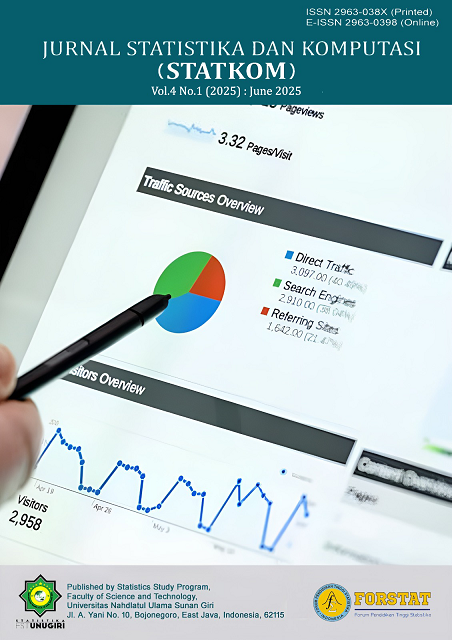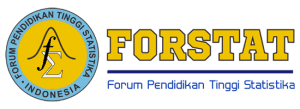Clustering Job Seekers in Bojonegoro Using K-Means and Fuzzy K-Means
 PDF Download: 92
SIMILARITY INDEX Download: 0
PDF Download: 92
SIMILARITY INDEX Download: 0
DOI:
https://doi.org/10.32665/statkom.v4i1.4651Keywords:
Job Seekers, Clustering, K-Means, Fuzzy K-Means, Workforce AgeAbstract
Background: Job seekers are part of the labor force who are unemployed and actively looking for work. One of the efforts to address the rising number of job seekers is by expanding job openings or employment opportunities. Employment is an essential need for individuals to meet various aspects of life, ranging from basic needs to education and housing.
Objective: This paper aims to analyze the frequency distribution of job seeker attributes in Bojonegoro, compare the K-Means and Fuzzy K-Means methods in clustering sub-districts, determine the best clustering method, and describe frequency distribution for each formed cluster.
Methods: The methods used are K-Means and Fuzzy K-Means, both known for their ease of implementation and effectiveness in clustering large datasets by minimizing the average distance between data points within each cluster.
Results: The majority of job seekers in Bojonegoro in 2022 are aged 15–24, unmarried, and senior high school graduates, with males comprising 59.6% of the total. The clustering analysis, with an optimal k equal to 5, reveals five balanced groups with distinct variations in age, gender, and marital status, suggesting a range of employment needs among subgroups.
Conclusion: The findings indicate that most job seekers in Bojonegoro are young, male, unmarried, and secondary school graduates. The clustering process identified five relatively even groups, with K-Means slightly outperforming Fuzzy K-Means in cluster cohesion.
References
Abdel-Aty, A., Mostafa, M. G., & El-Sherif, M. (2021). Comparative study of hard and fuzzy clustering algorithms in spatial data analysis. International Journal of Advanced Computer Science and Applications, 12(1), 145–152. https://doi.org/10.14569/IJACSA.2021.0120118
Alkodri, A. A., Sujono, S., Isnanto, B., & Maxrizal, M. (2020). Peningkatan Bidang Pendidikan Dan Pelatihan Keterampilan Bagi Pencari Kerja Dengan Basic Graphic Design. Jurnal Abdimastek (Pengabdian Masyarakat Berbasis Teknologi), 1(2). https://doi.org/10.32736/abdimastek.v1i2.1026
Almeida, J. A., de Azevedo, F. M., & Neto, P. A. (2021). Performance analysis of K-Means clustering with categorical data transformation techniques. Expert Systems with Applications, 173, 114669. https://doi.org/10.1016/j.eswa.2021.114669
Angela, A., & Honni, H. (2018). Prototipe Aplikasi Mobile Android YourDreamJS untuk Pelamar dan Pencari Kerja. JBASE - Journal of Business and Audit Information Systems, 1(1), 19–29. https://doi.org/10.30813/.v1i1.1141
Arnofia, L. (2022). fasilitas pencari kerja yang dilakukan disperinaker Bojonegoro. blokbojonegoro.com. https://blokbojonegoro.com/2022/06/02/fasilitasi-pencari-kerja-ini-yang-dilakukan-disperinaker-bojonegoro/?m=0
Arora, S., & Malik, S. (2020). Clustering techniques for data analysis: A review. International Journal of Computer Applications, 176(30), 15–19. https://doi.org/10.5120/ijca2020920672
Bezdek, J. C., Keller, J. M., Krishnapuram, R., & Pal, N. R. (2019). Fuzzy models and algorithms for pattern recognition and image processing. Springer. https://link.springer.com/book/10.1007/b106267
Fitriyah, H., Safitri, E. M., Muna, N., Khasanah, M., Aprilia, D. A., & Nurdiansyah, D. (2023). Implementasi Algoritma Clustering Dengan Modifikasi Metode Elbow Untuk Mendukung Strategi Pemerataan Bantuan Sosial Di Kabupaten Bojonegoro. Jurnal Lebesgue : Jurnal Ilmiah Pendidikan Matematika, Matematika Dan Statistika, 4(3), 1598-1607. https://doi.org/10.46306/lb.v4i3.453
Jain, A. K. (2020). Data clustering: 50 years beyond K-Means. Pattern Recognition Letters, 138, 489–499. https://doi.org/10.1016/j.patrec.2020.01.008
Kartini, A.Y., Nurdiansyah, D., & Cahyani, N. (2024). Metode Statistika. Madza Media.
Khan, A. S. S., Fatekurohman, M., & Dewi, Y. S. (2023). Perbandingan Algoritma K-Medoids Dan K-Means Dalam Pengelompokan Kecamatan Berdasarkan Produksi Padi Dan Palawija Di Jember. Jurnal Statistika Dan Komputasi, 2(2), 67–75. https://doi.org/10.32665/statkom.v2i2.2301
Kuncoro, J. (2022). Tahun 2022 tercatat 2.063 warga Bojonegoro menganggur. Suarabanyuurip.com. https://suarabanyuurip.com/2023/01/27/tahun-2022-tercatat-2063-warga-bojonegoro-menganggur/
Ningsih, W., & Abdullah, F. (2021). Analisis Perbedaan Pencari Kerja dan Lowongan Kerja Sebelum dan Pada Saat Pandemi Covid-19 di Kota Malang. Journal of Regional Economics Indonesia, 2(1), 42–56. https://doi.org/10.26905/jrei.v2i1.6181
Nurdiansyah, D., Hayati, E., Purnamasari, I., Hidayanti, A. A., & Rahayu, Y. F. (2024). Implementation of Clustering and Association for Early Warning of Disasters in Bojonegoro Regency. ComTech: Computer, Mathematics and Engineering Applications, 15(2), 119–127. https://doi.org/10.21512/comtech.v15i2.11933
Nurdiansyah, D., Saidah, S., & Cahyani, N. (2023). Data Mining Study For Grouping Elementary Schools In Bojonegoro Regency Based On Capacity And Educational Facilities. Barekeng: Jurnal Ilmu Matematika Dan Terapan, 17(2), 1081-1092. https://doi.org/10.30598/barekengvol17iss2pp1081-1092
Nurdiansyah, D., & Sulistiawan, A. (2023). Dasar Pemrograman Komputer Dengan Open Source Software R (Untuk Bidang Sains dan Teknologi). CV. AA. RIZKY.
Rochman, E. M. S., & Rachmad, A. (2020). Clustering Tourist Destinations Based on Number of Visitors Using the K-Mean Method. Proceedings of the 1st International Multidisciplinary Conference on Education, Technology, and Engineering (IMCETE 2019), 312–314. https://doi.org/10.2991/assehr.k.200303.075
Sallaby, A. F., & Suryana, E. (2018). Penerapan Data Mining untuk Menentukan Jumlah Pencari Kerja Terdaftar Berdasarkan Umur dan Pendidikan Menggunakan K-Means Clustering (Studi Kasus di Dinas Tenaga Kerja Dan Transmigrasi Provinsi Bengkulu). Journal of Technopreneurship and Information System (JTIS), 1(1), 35–38. https://doi.org/10.36085/jtis.v1i2.28
Salman, G. & Kurniati, P. (2022). Pencari Kerja di Surabaya Kini Lebih Mudah Akses Lowongan Pekerjaan lewat Aplikasi ASSIK. Kompas.com.
Simbolon, T. G. (2023). ADA 937.176 Pencari Kerja Di Indonesia Pada 2022. DataIndonesia.id.
Sukirman, S., Rosmiati, R., Alamsyah, N., & Kamal, K. (2020). Perancangan Sistem Informasi Kartu Kuning (Ak.1) Untuk Pencari Kerja Kantor Dinas Ketenagakerjaan Kota Makassar. ILTEK : Jurnal Teknologi, 14(2), 2067–2072. https://doi.org/10.47398/iltek.v14i2.418
Wang, Y., Li, J., & Gao, H. (2019). A hybrid fuzzy K-means clustering algorithm for data with outliers. Expert Systems with Applications, 124, 291–300. https://doi.org/10.1016/j.eswa.2019.01.016
Xu, C., & Tian, Y. (2019). A comprehensive survey of clustering algorithms. Annals of Data Science, 6(2), 221–252. https://doi.org/10.1007/s40745-018-0149-1
Yuliani, R., Setiawan, A., & Prasetyo, A. (2020). Analysis and design of job information systems for employment services. Jurnal Teknologi dan Sistem Komputer, 8(4), 237–244. https://doi.org/10.14710/jtsiskom.8.4.2020.237-244
Downloads
Published
Issue
Section
License
Copyright (c) 2025 Adam Al Avin Faisal Hutin

This work is licensed under a Creative Commons Attribution-ShareAlike 4.0 International License.
Authors who publish with this journal agree to the following terms:
- Authors retain copyright and grant the journal right of first publication with the work simultaneously licensed under a Creative Commons Attribution License - Share Alike that allows others to share the work with an acknowledgment of the work's authorship and initial publication in this journal.
- Authors are able to enter into separate, additional contractual arrangements for the non-exclusive distribution of the journal's published version of the work (e.g., post it to an institutional repository or publish it in a book), with an acknowledgment of its initial publication in this journal.
- Authors are permitted and encouraged to post their work online (e.g., in institutional repositories or on their website) prior to and during the submission process, as it can lead to productive exchanges, as well as earlier and greater citation of published work.
USER RIGHTS
All articles published Open Access will be immediately and permanently free for everyone to read and download. We are continuously working with our author communities to select the best choice of license options, currently being defined for this journal as follows:
 PDF Download: 92
SIMILARITY INDEX Download: 0
PDF Download: 92
SIMILARITY INDEX Download: 0












